Karl Nordström
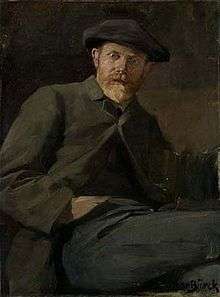
Karl Fredrik Nordström (11 July 1855, in Stenkyrka, Västra Götaland – 16 August 1923, in Drottningholm), was a Swedish painter and one of the leading members of Konstnärsförbundet, which he chaired from 1896 until its dissolution in 1920.
Biography

Born on the island of Tjörn on the Swedish West Coast, Nordström studied at principskolan, the preparatory school of the Royal Academy of Arts in Stockholm and the private painting school of Edvard Perséus, but was never promoted to the "Antique school" of the Academy and had to continue on his own. Traveling to Paris in 1881, he was influenced by the impressionists. He spent a couple of years in Grez-sur-Loing, the site of an important colony of Scandinavian artists, practising his plein air painting in the strong French sunlight. In 1885, he joined a group of young artists protesting against the policies and leadership of the Academy; starting from 1886 he was one of the leading members of Konstnärsförbundet, the formalization of the opposition group. He served as chairman from 1896 until its dissolution in 1920.
In 1886, he married xylographer and photographer Tekla Lindeström in Paris. Later the same year, he settled on Tjörn, using what he had learnt in France about light and colours to depict the landscape where he had grown up. He spent the summer of 1889 in Visby.
- Paintings
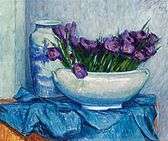 Blue crocuses
Blue crocuses Dawn Mt Chocorua
Dawn Mt Chocorua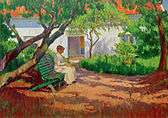 In the garden
In the garden
Style

Around 1890, he moved from his earlier impressionism towards a more synthetist style. His influences came from Japanese art, which he had encountered in Paris, and from Gauguin, whose paintings he had first seen in photographs he had received from Ivan Aguéli.
One of Nordström's old friends from the time at the Academy and in Perséus' school, Nils Kreuger, had lived in the city of Varberg since 1888. He convinced Nordström to move there in 1892 where they were joined by another of their old friends, Richard Bergh, in 1893. He renewed his acquaintance with the work of Gauguin in Copenhagen in 1892, and, with works by van Gogh, exhibited there the next year. His landscapes from Varberg and the Halland countryside were often characterized by the warm sunlight of dawn or dusk or the light Nordic summer nights and a progressively more synthetist style.
- Landscapes
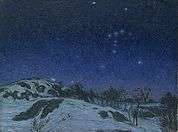 Winter night
Winter night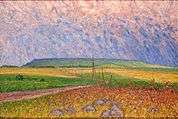 Alleberg
Alleberg Regnbågen/The Rainbow
Regnbågen/The Rainbow Field of Oats at Grez
Field of Oats at Grez%2C_1909.jpg) Skäret/The Skerry
Skäret/The Skerry Kyrkesund
Kyrkesund
References
| Wikimedia Commons has media related to Karl Nordström. |
- Rausing, Birgit: "Måleriet", in: Signums svenska konsthistoria. Konsten 1890-1915, Lund: Signum, 2001, pp. 203-335.
- Schaffer, Barbro: "Nordström, Karl Fredrik", Svenskt biografiskt lexikon, 27, pp. 465-472.